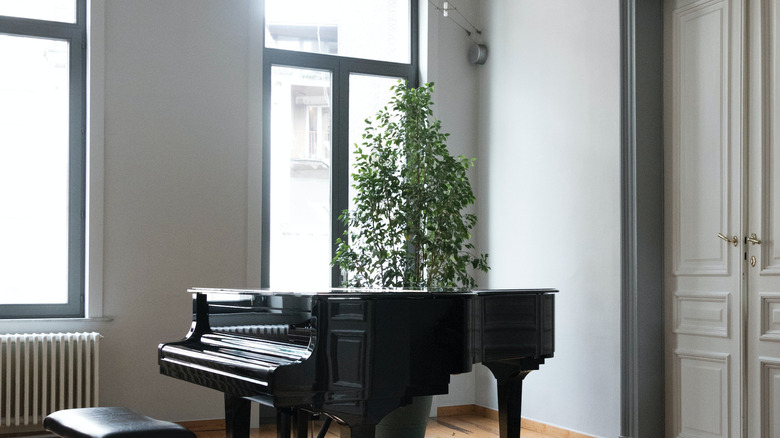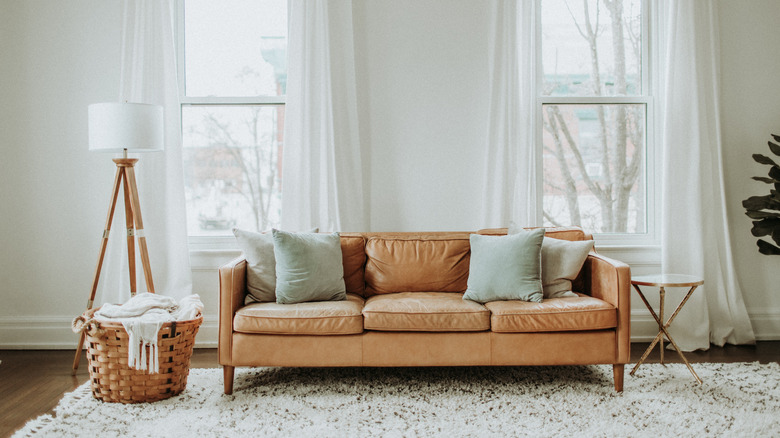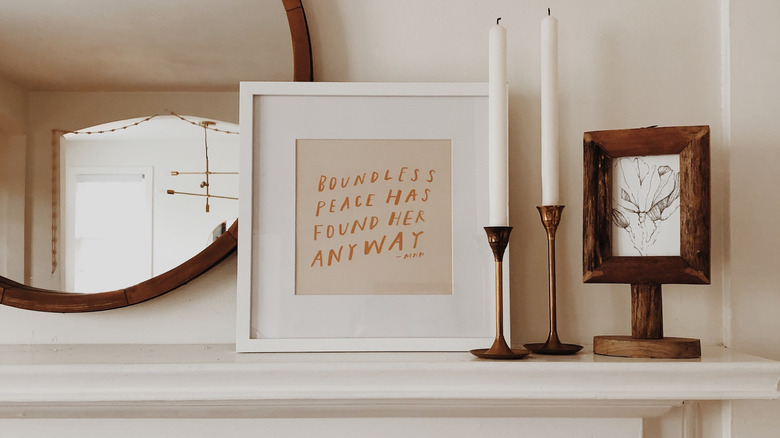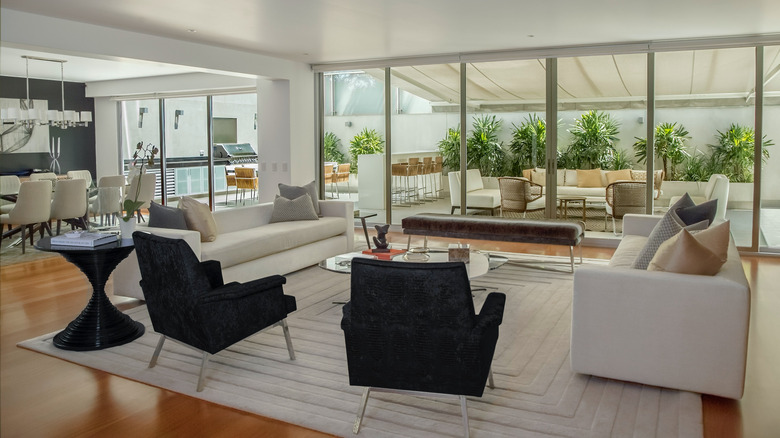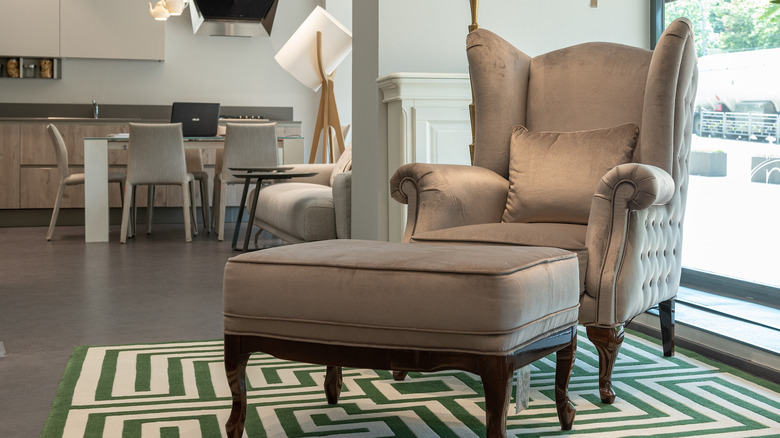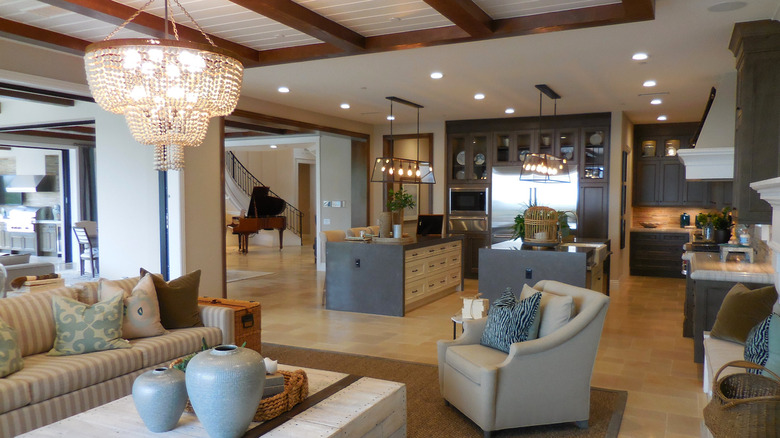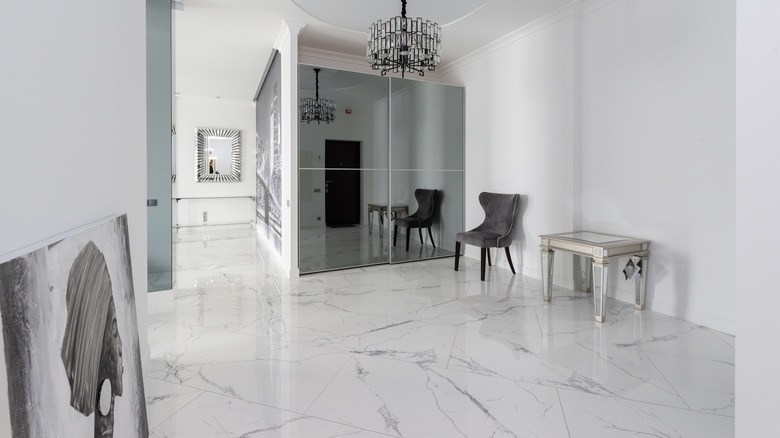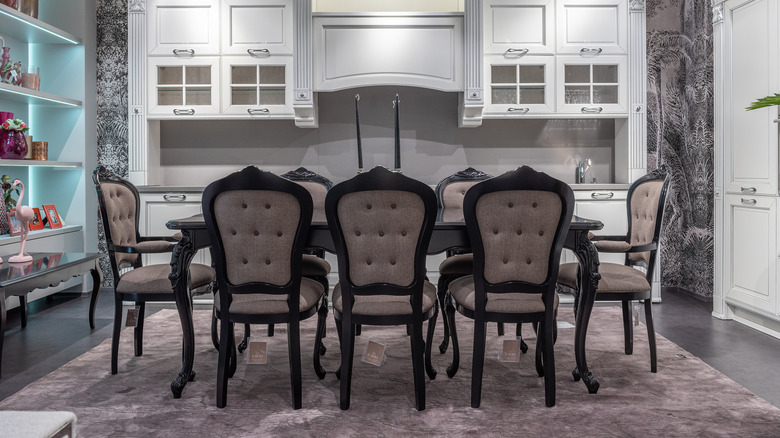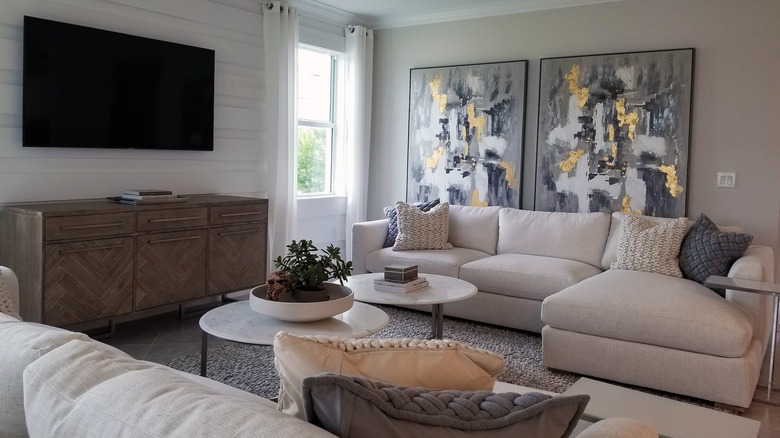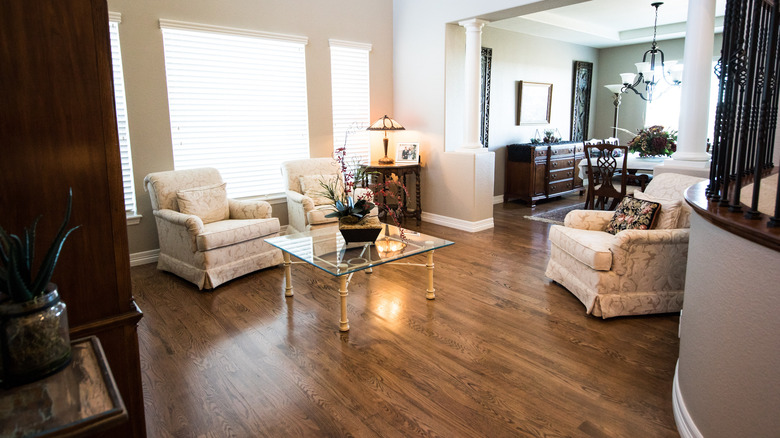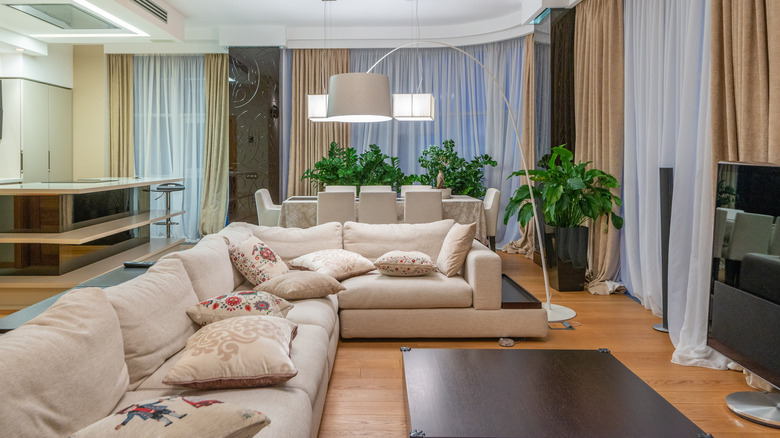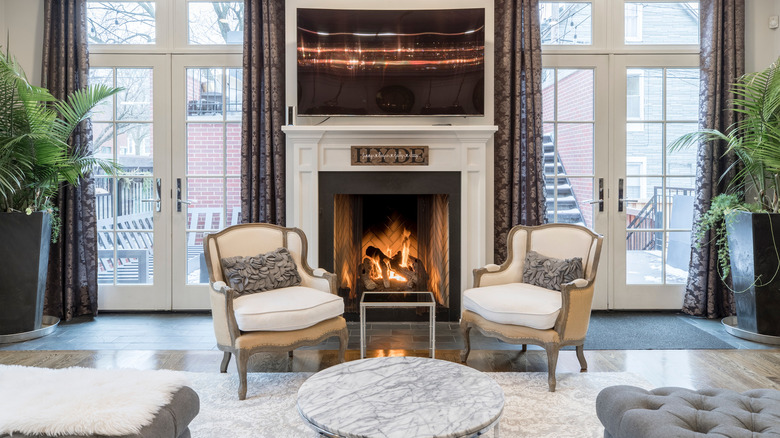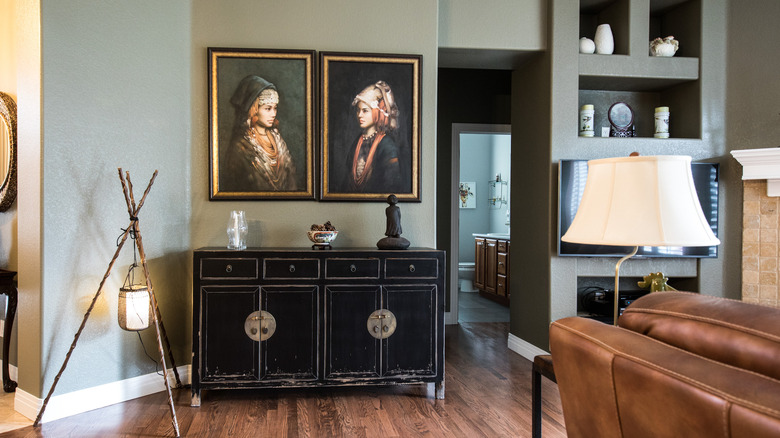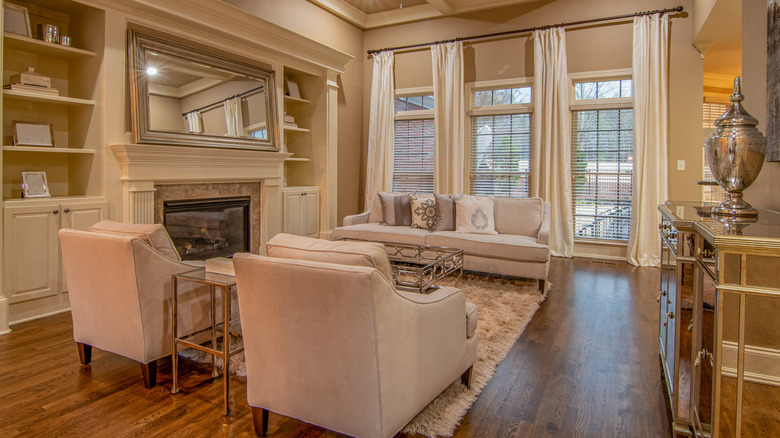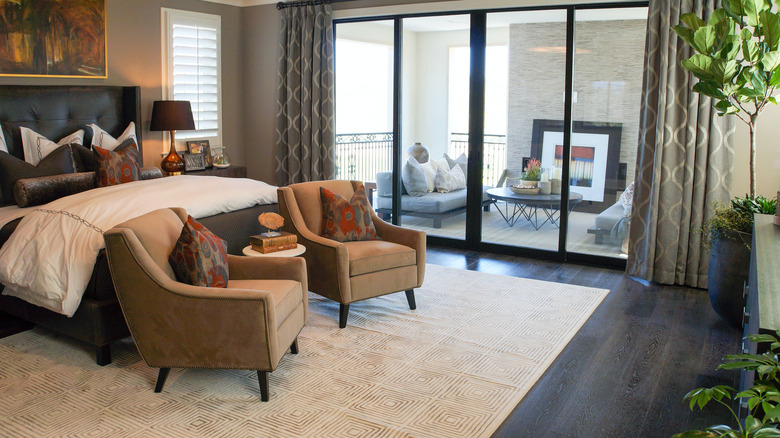The Ultimate Guide To Traditional Decor
Traditional decor is an a very approachable style that defines what "cozy" ultimately means to you. This classic style preference has lasted throughout the years simply because "it works and is comfortable," according to Miles Redd via Architectural Digest. When creating this design trend in your home you want to try and keep the look simple: Keep the colors toned down, accents to minimum, and designs symmetrical. Traditional home decor is full of clean lines, classic looks, and fixtures that offer diversity in terms of scale.
While bold colors may be absent in the decorative scheme, the intricate details found in the accent items like pillows and rugs will add the necessary depth the room requires. This neutral aesthetic is popular and enduring, making it an easy favorite amongst home dwellers. Whether you are just getting started, looking for a change, or want to update a room, continue reading to find the inspiration you need to complete your ultimate traditional decor look at home.
Add soft pillows with detail
Details in traditional decor styling are minimal, giving way for the decorator to play up patterns within the accent pieces in the room. Pillows are an ideal decorative accent item in any home, and they are perfect for filling in empty space. This plush accessory introduces a cozy vibe, and, with the right embroidery, stitching, or pattern, can pack a punch of visual texture into an otherwise-colorless environment. Break the rules if you desire, but The Spruce suggests sticking to three colors, three patterns, and three styles when choosing pillows for your decor.
One should try to mix and match similar hues of creams, grays, and taupes for the perfect neutral pillowscape on your couch or bed. You could also combine pillows that have floral designs or stripe patterns and ones with tassel accessories at the corners. When completing your ultimate traditional look, do not hesitate to get creative with the pillow designs, as this is one of possibly few opportunities for you to arrange decor in stylish combinations that represent you.
Conservative neutral colors
When decorating in a traditional style, the somewhat-restrained color choices are part of the overall look. According to SFGate, it's a good idea to incorporate neutrals into the color palette, since these tones tend to blend well with traditional furnishings. Beige, grays, any shade of white, cream, or greige will be the go-to hues for covering the walls and ceilings, as well as the primary tone for rugs and other floor coverings.
Sticking to a conservative color palette on the walls in your home will allow the additional furnishings to be the standout elements. Since the backdrop is so neutral, things such as the shape of your furniture or the textures among the various items stand out much more and become focal points. Bold pops of color aren't really common in traditional design, so you'll have to look for ways to add interest, and this makes the shape, style, and texture of your furniture itself even more important.
Invite conversation with furniture placement
When designing their living room, it is important for one to consider the functionality the items will have in the space. Once the desired seating selections are made, aim to organize them in a layout that fits the room. Sofas and accent chairs that are too big will interrupt natural walkways and create a chaotic environment in the furniture display. You want to make sure to leave ample room between the seating arrangement and tables so when corralled together in the same environment, they create a pleasing arrangement.
To achieve a successful traditional layout in your home, try to group the furniture pieces in a way that invites conversation into your space. Traditional decor is about embracing comfort, so one's guests should feel the same energy from the furniture set-up. According to DecorAid, facing furniture pieces toward one another will stimulate conversation between your guests. For alternative options for discourse, one could pair accent chairs side by side, and even consider adding unique seating arrangements such as ottomans and poufs.
Bring the room to life with a rug
When adding the perfect level of comfort to your space, a plush area rug seems like an obvious layer to include in any room. Rugs cover a vast amount of floor space, providing just the layer of softness a room needs. They can be composed of intricate details that have a ton of movement, and vibrant patterns that elevate a floor space in a similar way that wallpaper or paint can alter a wall.
Add warmth and coherence to a space by layering your favorite accent rug under a sofa, master bed or dining room table. This decor concept makes these elements stand out, and layering colors, textures, and shapes adds more interest to the environment. Traditional-style rugs are offered in multiple colors, including neutrals, and may even display a life scene. Natural fabrics like jute and wool, and low-pile rugs with simple designs are fantastic neutral options to consider for your space. Using rugs to cover floor space is yet another chance for the decorator to use large-scale pieces in neutral tones to bring a look to life in a traditionally-styled domain.
Add rich wood furnishings and moldings
When creating a traditional style decor scheme in your home, you want to have furnishings that are representative of different eras to help increase the glamour and charm. To achieve a formal look, try to add vintage pieces with contemporary ones for a more modern traditional aesthetic. Coffee tables, sofa tables, and dressers are some large furnishings you can add to your space to introduce those vintage wood tones, since they are typically crafted from rich wood like mahogany, oak, and birch.
Finding ways to up-cycle wood tables and cabinets is a budget-friendly way to get the traditional look in your home for less. Stain it, paint it, or, as Dengarden suggests, leave wood in its natural state to showcase the ornate designs, carvings, and twisted details. Details are important in traditional decor, and wood elements can be incorporated not just in furniture but in the wall moldings, too. Crown molding is a traditional wall trim that can complement this decorative preference well and add character to your space.
Match metal accents
Traditional decorating is simple and basic, which means that neutral metallic accents are the ideal decorations to brighten the look in your space. Metallics are versatile and effortlessly blend with wood, other metals, different paint colors, and patterns that may exist in your home. When choosing which metals to add to your desired space, select pieces that help achieve a cohesive look.
According to Living Spaces, matching metals in a space amongst like elements will help create harmony, which is necessary in a traditionally-influenced home. Adding in metallic materials on the shelves that are similar to the furniture handles or legs will help unite the overall design. Decorating with matching metallics creates contrast in the space without introducing bright colors and abstract designs. These accents pop against the neutral colors commonly found in traditional home decor and will help create the ultimate traditional vibes in your space.
Wallpaper with patterns
Traditional decor does not mean boring! Patterns are still highly acceptable in this decor preference and will likely introduce movement into an otherwise-static environment. If the room is a blend of solid neutrals, try to break up the decor scheme with patterns. Introduce a wallpaper that complements the existing neutral color palette but has a design that will elevate your look. Try sourcing wallpaper that showcases delicate floral elements or simple stripes that work with the classic forms in traditional decor.
When selecting a wallpaper for your home, one should consider how the pattern they love will blend with the existing artificial and natural light in the environment. "This can affect the look of wallpaper and make the color appear lighter or darker," advises David Harris via House Beautiful. Not all wallpaper looks the same in your home as it may appear in other settings. Tones and undertones may appear differently in your own dwelling as the light is not only different but changes throughout the day.
Hang artwork to capture the eye
If wallpapering an entire wall seems too daunting or simply is not a desirable feature in your home, perhaps you could contemplate hanging artwork that fills the wall space instead. This decorative element can capture the eye with its size, form, or displayed image. Traditional artwork is typically of natural elements, animals, landscapes, and fauna. Regardless of which scenery you choose to portray, be mindful of where you plan to hang the piece as you want to maintain traditional forms.
When hanging artwork over furniture pieces it is a general guideline for one to follow that the arrangement, whether one or multiple, be 50 to 75 percent of the width of the furniture piece per Ballard Designs. These desirable dimensions cover just the right amount of wall space without overpowering the structural elements in the room. The height arrangement will also help capture the eye's attention by creating a correspondence in the decorative elements of your space.
Balance the patterns in the room
While traditional decor is typically composed of solid neutral shades there are often opportunities where patterns help to balance the design scheme. When mixing patterns and solid colors or multiple patterns in one space, Ballard Designs suggests pairing neutral solid tones with a set of chairs in a bold pattern. A combination of neutral hues with furniture items in purposeful patterns will maintain balance in a traditional home style. To create interest, traditional design doesn't rely on bold color, but rather a focus on introducing items with complementary patterns to the existing neutral color palette.
What does that look like? The picture above displays it beautifully by showcasing how to take a patterned object in an achromatic tone and mesh it together with existing shades of neutral color. Stick to a similar path when pairing like patterns in the same space, as you want to keep them alike enough that they complement one another but slightly different so that the eye detects the deviation. This is a fantastic way for a traditional decor aficionado to incorporate movement without altering appearance in their space.
Decorate with accessories that play with scale
Traditional decor is simple, yet finds its distinctiveness in the scaled accessories in the room. If you are looking to add a feature that impacts a space in a bold way, consider varying the size of the art on the walls in your home. "Add bold large-scale pieces to make a statement," says Lori Henle via MyDomaine, "as opposed to lots of smaller pieces." This decorative design still adheres to the classic forms and streamlined looks found in traditional decor elements.
When you consider hanging oversized canvas art or tall framed artworks, it allows you to not only cover a large wall easily but also add a beautiful focal element to the space as well. Keep the design simple and the colors complementary to existing neutral tones in the home as you want to maintain a cohesive look. Large busts, candlesticks, oversized table sculptures, and floor lamps are other accessories to consider adding into a room for a perception change that tips the scale.
Marble mantels and accessories
When decorating in traditional style, it is often the goal of a decorator to achieve simple yet elegant grace in their space. According to Architectural Digest, accenting your mantel with a marble top may be just the element you need to introduce a timeless, traditional look into your space. No mantel, no problem. One could find ways to incorporate marble accents in other forms if a mantel is not available.
Marble statues added to sofa tables or bookshelves, decorative links layered on a stack of books, marble-topped end tables, or kitchen backsplashes are some ways to add this material into your home for a successful traditional decor influence. Marble is one of those special materials that can produce a luxurious home vibe effortlessly. The color choices offered in the material are ideal for traditional decor as they are commonly crafted in shades of taupes, creams and other neutral color tones complementary to traditional home decor.
Pair it with another style for originality
According to Modsy, traditional decor is a very flexible style and can be paired with other styles for a more curated look. One could keep the decor elements in the home traditional in form, and use this style favorite as a base for their home design scheme. To amplify the look with a personal twist, a decorator can incorporate subtle elements from other design categories for a specific flare.
One could consider seashells for coastal inspiration or French-inspired mirrors paired with contemporary tables for a subtle vintage vibe. Combining elements such as mirrors with unlikely furniture pieces, introducing rustic accents, or incorporating beach elements will form a traditional look that is truly you. Traditional style endures due to its versatility and capability to mesh with individuality, making it a desirable design approach for those whose preferences change over time. Traditional style is about building a home that reflects comfort, so decorate with items in a way that can invoke that sensation in your space.
Simply dress up your windows
When decorating a home, windows are a pivotal structural element to consider decorating, as they naturally draw one's attention by offering an outwards glance. Bare windows can leave a room feeling empty, which is why Spring Haus suggests a simple window treatment to introduce an earthy warmth into the space. Rather than leave the area around the window empty, opt to get creative and find ways to dress up the window with curtains, shades or valances.
Warm tones in neutral colors are perfect for creating the ultimate traditional look in your home. Try creating a bit of contrast in the environment by adding window curtains that are opposite of the wall color, yet still maintain a neutral shade. For example, if the walls are tan, try adding a white curtain to the window so it stands out along the wall. Follow a similar approach with other color combinations for an equally-diverse appearance.
Create symmetry in the space
When you are decorating in a traditional style, it's important to maintain a symmetry throughout your space, especially amongst the decorative elements and furnishings. "Consoles and foyer tables are the best furniture to create symmetry with for most people," shared Maureen Stevens via Homes & Gardens. The effect is congruent and streamlined, pairing well behind sofas or against walls at the entry. Other furnishings such as chairs, sofas, footstools, lamps, and accessories are often in pairs and can be used to create uniformity in the home.
The pairing of items helps maintain balance in the space and creates a pleasant visualization in the room. When decorating, strive to create a symmetrical space, as it is often pleasant to a person's view of a room and can produce the serene and timeless surroundings commonly found in traditional design. The ability to maintain balance in the furniture, harmony amongst the accessories, and cohesion in the window and wall ornaments will help you create the ultimate traditional interior.
